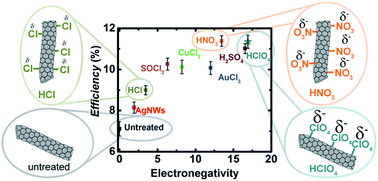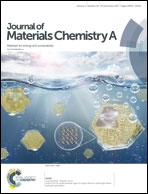Insights into chemical doping to engineer the carbon nanotube/silicon photovoltaic heterojunction interface†
Abstract
Graphene oxide/single-wall carbon nanotube (GOCNT) hybrid films have been used to fabricate heterojunction solar cells with silicon (Si) due to their compatibility with both aqueous and organic processing. In these cells GOCNT films are required to be both highly transparent and conducting. Different approaches are used to improve these optoelectronic properties of the GOCNT films, including hybridization with silver nanowires (AgNWs) and p-type doping with CuCl2, AuCl3, SOCl2, HCl, H2SO4, HNO3 and HClO4. UV-vis-NIR absorbance, Raman spectroscopy, and the sheet resistance of the films were used to evaluate the properties of the treated films and quantify doping. The most effective way to improve the optoelectronic properties of the GOCNT films was the incorporation of AgNWs which improved the figure of merit (FOM, the ratio of transparency and conductivity) by over 600%. However, GOCNT/Si heterojunction photovoltaic devices with HNO3 doped GOCNT films showed the highest solar photocurrent conversion efficiency (11.38 ± 0.26%). In terms of stability, CuCl2 and HCl doped films have the best electrode FOM stability, and devices made with such films have the most stable efficiency as well. This report suggests that the electronegativity of the active elements in the dopants has a strong influence on the optoelectronic properties of the films as well as the solar cell performance.



 Please wait while we load your content...
Please wait while we load your content...